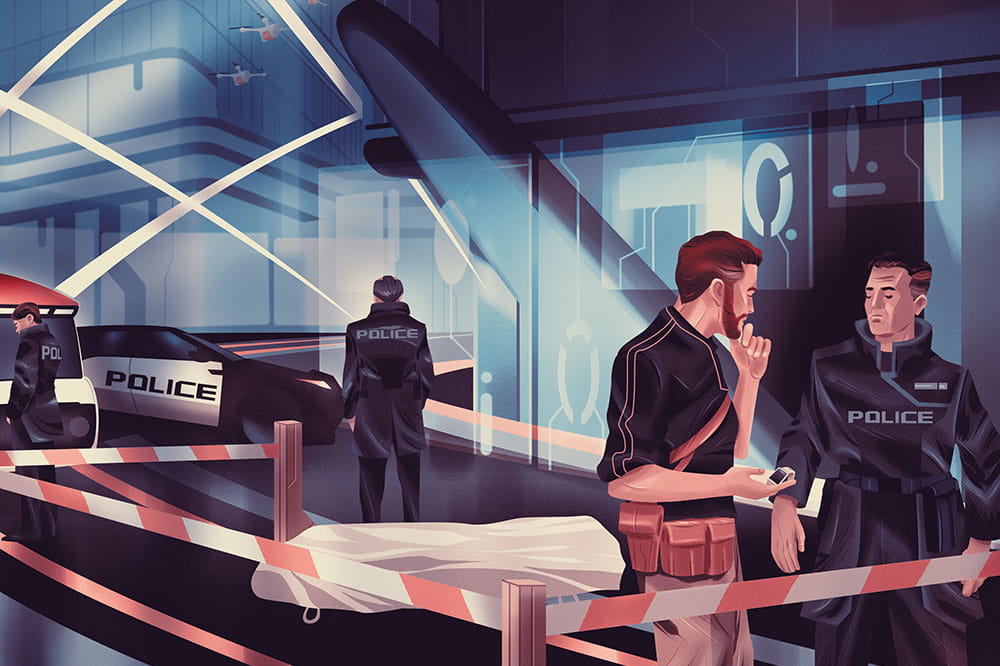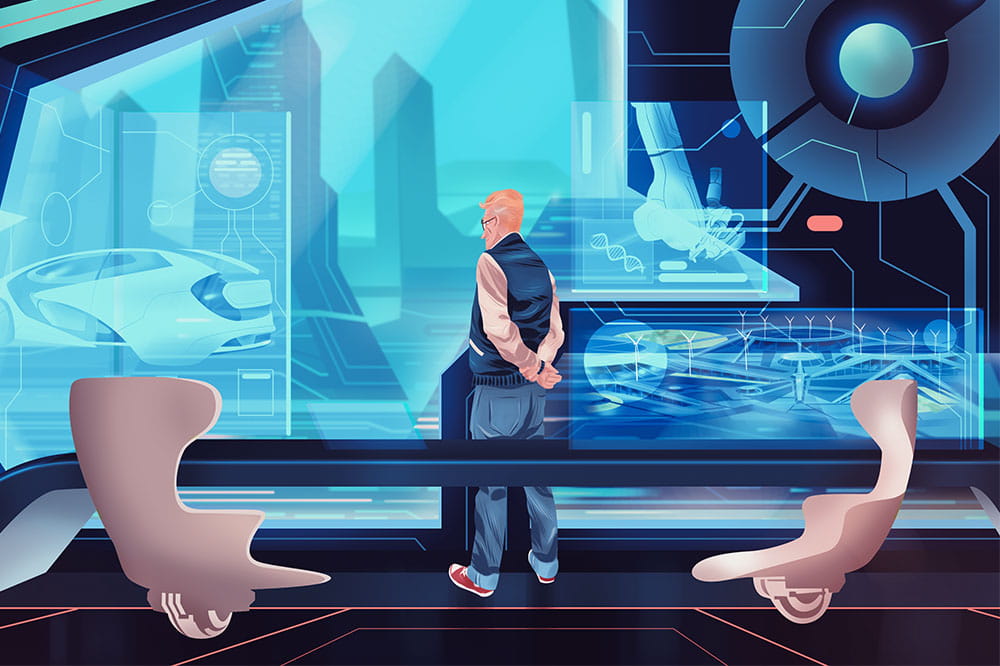Obtain news and background information about sealing technology, get in touch with innovative products – subscribe to the free e-mail newsletter.

TRAVELING INTO THE FUTURE
Each month, you can find a new chapter in the ESSENTIAL science-fiction series “Trip into the Future.” In a fictional world where the goals of the Paris climate accord have become a reality, Nero, a blogger, explores the potential technological and social transformation resulting from it. The goal of the series is to play with fully different visions as creatively as possible and to take the reader along on a thought experiment: What might our future look like – and why is it important to us?
Short Science Fiction Stories: Part 12
Attack on Alaska Star V
Not now, I thought. I desperately needed a few hours of sleep. That was hard enough with a ten-hour time difference. But the ceiling illumination of my hotel room was blinking stubbornly. Avar, my personal AI assistant, only does that when there is a real emergency. It is how she communicates with me when I switch her to the “Do Not Disturb” mode. There was even a short text message on the ceiling:
Cyberattack on Alaska Star V
That could not be. It was technically impossible – completely preposterous. It’s the year 2045! Cyber wars are a thing of the distant past. Data communication was converted to quantum cryptography about twenty years ago. The reason was the complete failure of the global network in the early 2020s, triggered by an international cyber terrorist group’s attack on dozens of Internet hubs. The entire system collapsed: the electric grid, transportation and most of the factories that had been networked with Industry 4.0 technology. Through the concerted action of the United States of America, the United States of Europe, China and the African Union, the network was re-stabilized piece by piece. After just a week, refrigerators and factory equipment were running again. The economic damage: roughly $1.5 trillion U.S.

What happened next was even more significant: Over a short span of time, the international community launched dozens of satellites solely for the purpose of quantum communication. It also invested in the construction of a common network of quantum computing centers. Most of them were built in remote locations in northern latitudes. These facilities have two advantages: First of all, they are easy for the international security forces to protect; secondly, the outdoor temperatures are so low that the supercomputers can be cooled with ambient air most of the year. The highest performing quantum computing center of all time, Alaska Star V, is in Anchorage. It was due to be inaugurated the next day. I was in town to report on its launch for my tech blog.
“Okay, Avar, what’s up? Are you sure this is not a deliberate false report by a post-factualist?” My assistant answered softly: “I’m sorry for keeping you from your rest. But the message came straight from the global Interior Ministry. There will be a press conference at the computing center in an hour, and the minister himself is going to speak. That’s all I know.” I got up and asked Avar to book one of the share-scooters parked in front of the hotel for me.
An hour later, I was in a heated tent on the computing center grounds. It was put up especially for the opening ceremony. “Ladies and gentlemen,” the interior minister said at the start of his impromptu speech, “like every other computing center in the Star model line, Alaska Star V is connected to the global network exclusively by means of quantum satellite communication. You all know it is absolutely impossible to physically falsify a message encrypted with quantum cryptography. But this is precisely what must have happened a few hours ago. We found malware on one of the computers. We have to assume that we are dealing with a very powerful attacker who has taken control of at least one of the Star satellites. Alaska Star V is off line. Investigations by the leading experts from all the participating countries have begun. Please understand that I can’t say more or answer questions at this point.” There was immediately an uproar. Reporters from across the globe were shouting questions across the room. But not me. I slumped into my seat. Something was wrong. But what was it?

I had to eat something. I can’t think when I’m hungry. The tables set up for the buffet for the next day were empty. But the caterer’s delivery truck was already parked in front of the tent. I went outside through the side entrance and watched a man in blue coveralls balancing a plate of salmon rolls in his left hand while activating an iris scanner for the center’s door opener with his right. This was presumably food for the engineers. They could certainly spare one salmon roll. I walked toward the man, but he disappeared. I barely managed to get my hand into the doors before they closed. The corridor beyond it was empty. I was familiar with these double-door systems from my previous visits to computing centers. Normally, the second door at the other end is accessible only with another ID check. But here it was open – strangely enough, without an alarm activating after twenty seconds as it would ordinarily. I had a sneaking suspicion about what I was seeing. I raced out of the building. Back at the tent, I found one of the security guards: “Officer…”
The next morning, the interior minister was standing before reporters at a second hastily called press conference. “Ladies and gentlemen, I have two pieces of good news. First of all, quantum communication continues to be absolutely secure. The attack on Alaska Star V took place in a different – let’s say old-fashioned – way. A number of individuals disguised as the catering staff succeeded in penetrating the building physically and manipulating one of the quantum computers despite the massive security measures. The second piece of good news is that the cyber terrorists were arrested last night thanks to an alert journalist with a craving for salmon rolls. Alaska Star V will begin its regular operation as scheduled today.”
On the Trail…
“Xinyi?” Cliona said into the microphone. “Are you down there?” “Down there?” said the voice from the headphones, “You know very well where I am.” “Someone is down there.” “What do you mean, ‘down there,’ Cliona?” “Hmm. I may be going straight up.” The height gauge on her work glasses indicated that she was already nine meters in the air. The prongs suddenly stopped, and the mast swayed. “Cliona?” It was Xinyi’s voice. “Someone has manually turned off the electronic mast stabilizer on the forklift. Was it you? Why did you do that?” Uh-oh. “Could you please turn it on again quickly?” Cliona said into the microphone. Her voice may have quivered a bit. “And then call Security. There’s someone here.” The prongs began to move again. Everything was shaking and swaying as the mast continued its rapid climb. The height gauge showed twelve meters, then fifteen meters. She held on tight but, with her knowledge of physics, she knew that a mast with a full-grown woman was carrying too much weight at that height – it would swing from side to side without a stabilizer. If the vehicle below were to tip over… “I can’t switch the forklift off,” Xinyi said. “Where are you? Cliona was now sure that she was on the trail of someone or something. It would do her little good if she were right and that “someone” sent her crashing to the floor from this height. “Watch out!” her avatar – her constant non-physical companion – told her. “You are swaying badly. You may be drunk. Drink some water or lie down.” You have no idea, Cliona thought. Eighteen meters. Shouldn’t this stupid automated vehicle slowly realize that it could never retrieve a crate from the rack in its current state? And this is what we call artificial intelligence? The entire mast seemed to quiver and vibrate, thoroughly shaking Cliona. Her right foot seemed ready to slip.
More Stories About Future Files

Join Us!
Experience Freudenberg Sealing Technologies, its products and service offerings in text and videos, network with colleagues and stakeholders, and make valuable business contacts.
Connect on LinkedIn! open_in_new









